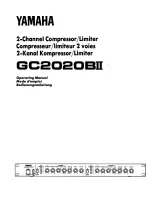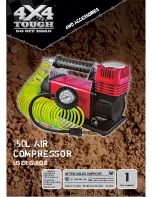
TS20C USER MANUAL
SECTION 2
18
2.5
CONTROL SYSTEM—
FUNCTIONAL DESCRIPTION
FOR TS20C
Refer to
. The purpose of the compressor
control system is to regulate the amount of the air
being compressed to match the amount of
compressed air being used. The Capacity Control
System consists of a pneumatic inlet valve, solenoid
valve, pressure regulator valve and a pressure
transducer. The functional description of the Control
System is described below in four distinct phases of
operation. The following description text applies to all
series compressors with the Supervisor Controller.
For explanatory purposes, this description will apply
to a compressor with an operating range of 100 to
110 psig (6.9 to 7.6 bar). A compressor with any
other pressure range would operate in the same
manner except stated pressures.
START MODE—0-50 PSIG (0 TO 3.5 BAR)
When the compressor
(
START
) button is
depressed, the sump pressure will quickly rise from 0
to 50 psig (0-3.4 bar). During this period both the
pressure regulator and the solenoid valve are closed,
the inlet valve is fully open and the compressor
pumps at full rated capacity. The rising compressor
air pressure is isolated from the service line in this
phase by the minimum pressure valve set at
approximately 50 psig (3.4 bar).
FULL LOAD MODE—50 TO 100 PSIG (3.4 TO 6.9
BAR)
When the compressed air pressure rises over 50
psig (3.4 bar) the minimum pressure valve is opened
allowing compressed air to flow into the service line.
From this point on the line pressure is continually
monitored by the Supervisor™ Controller, which
controls the variable speed drive. The pressure
regulator and the solenoid valve remain closed
during this phase. The inlet valve is in the fully open
position as long as the compressor is running at 100
psig (6.9 bar) or below.
MODULATING MODE WITH SPIRAL VALVE—100
TO 110 PSIG (6.9 TO 7.6 BAR)
As air demand drops below the rated capacity of the
compressor, the line pressure will rise above 100
psig (6.9 bar). As a result, the differential pressure
regulator for the spiral valve gradually opens,
applying air pressure to the spiral valve actuator. Air
pressure at the actuator expands the diaphragm. The
rack, in turn, engages with the pinion mounted on the
spiral valve shaft assembly. This results in a rotary
motion. As the spiral valve rotates, it starts opening
the bypass ports gradually. Excess air is then being
returned back internally to the suction end of the
compressor unit. Now the compressor is fully
compressing only that amount of air, which is being
used. As air demand keeps dropping further, the
spiral valve keeps opening more and more until all
the bypass ports are fully open. At this point, the
spiral valve has moved into the unload (minimum)
position.
The spiral valve provides a modulation range from
100 to 50%. During this period, the pressure rises
approximately from 100 to 105 psig (6.9 to 7.2 bar).
As the air pressure exceeds 105 psig (7.2 bar), the
differential pressure regulator controlling the inlet
poppet valve starts opening and forcing the poppet
closed, thus throttling inlet air flow to the compressor.
The inlet poppet valve provides a modulation range
from 50 to 40%. During this period, the pressure
rises approximately from 106 to 110 psig (7.3 to 7.6
bar). During this range, the spiral valve remains in
the unload position.
UNLOAD MODE—IN EXCESS OF 110 PSIG (7.6 BAR)
When a relatively small amount or no air is being
used, the service line pressure continues to rise.
When it exceeds 110 psig (7.6 bar), the Supervisor™
control system de-energizes the solenoid valve
allowing line air pressure to be supplied directly to
close the inlet valve. Simultaneously, the solenoid
valve sends a pneumatic signal to the blow down
valve. The blow- down valve opens to the
atmosphere, reducing sump pressure to
approximately 25 to 30 psig (1.7 to 2.1 bar). The
check valve in the air service line prevents line
pressure from returning to the sump.
When the line pressure drops to the low setting cut-in
pressure; usually 100 psig (6.9 bar) on low pressure
[“L”] compressors; 125 psig (8.6 bar) on high
pressure [“H”] compressors; 150 psig (10.3 bar) on
[“HH”] compressors; and 175 psig (12.0 bar) [“XH”].
Supervisor energizes the solenoid valve and allows
NOTE
Always refer to the machine nameplate for
designed operating pressure.
Summary of Contents for TS20C
Page 10: ...NOTES 10...
Page 13: ...SECTION 2 TS20C USER MANUAL 13 Figure 2 2 Sullair Rotary Screw Air Compressor Air Cooled 200HP...
Page 14: ...TS20C USER MANUAL SECTION 2 14 Figure 2 3 Sullair Rotary Screw Air Compressor Air Cooled 250HP...
Page 23: ...NOTES 23...
Page 64: ...TS20C USER MANUAL SECTION 2 64 Figure 2 22 TS20C SSRV NC SUPV AC WC 02250178 822 R02...
Page 66: ...TS20C USER MANUAL SECTION 2 66 Figure 2 23 TS20C CUST STR SUPV AC WC 02250178 823 R02...
Page 68: ...TS20C USER MANUAL SECTION 2 68 Figure 2 24 TS20C MFV NC SUPV AC RC 02250178 824 R02...
Page 70: ...TS20C USER MANUAL SECTION 2 70 Figure 2 25 TS20C MFV NC SUPV AC VSD FAN 02250178 825 R02...
Page 72: ...NOTES 72...
Page 76: ...SECTION 3 TS20C USER MANUAL 76 Figure 3 2 Identification TS20C Typical 02250175 122 R03...
Page 78: ...TS20C USER MANUAL SECTION 3 78 Figure 3 3 Identification TS2C0 200HP AC 02250175 130 R03...
Page 80: ...TS20C USER MANUAL SECTION 3 80 Figure 3 4 Identification TS20C 250HP AC 02250175 136 R02...
Page 84: ...TS20C USER MANUAL SECTION 3 84 Figure 3 6 Identification TS20C 200HP WCAC SER 02250175 148 R03...
Page 86: ...TS20C USER MANUAL SECTION 3 86 Figure 3 7 Identification V200TS 100 150HP AC 02250182 109 R02...
Page 100: ...NOTES 100...
Page 107: ...SECTION 4 TS20C USER MANUAL 107...
Page 108: ...NOTES 108...
Page 110: ...NOTES 110...
Page 122: ...TS20C USER MANUAL SECTION 7 122...
Page 123: ...NOTES 123...
















































